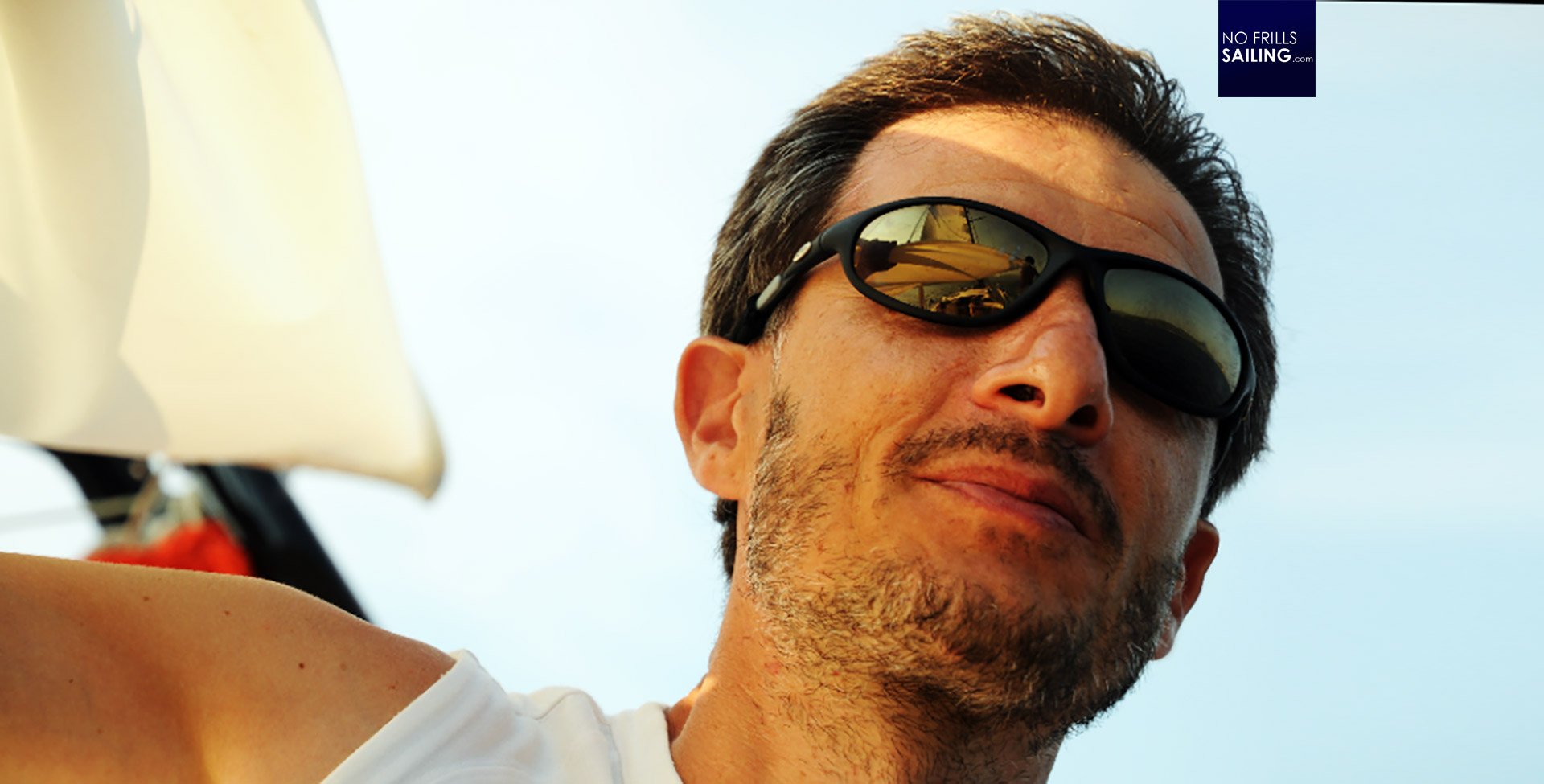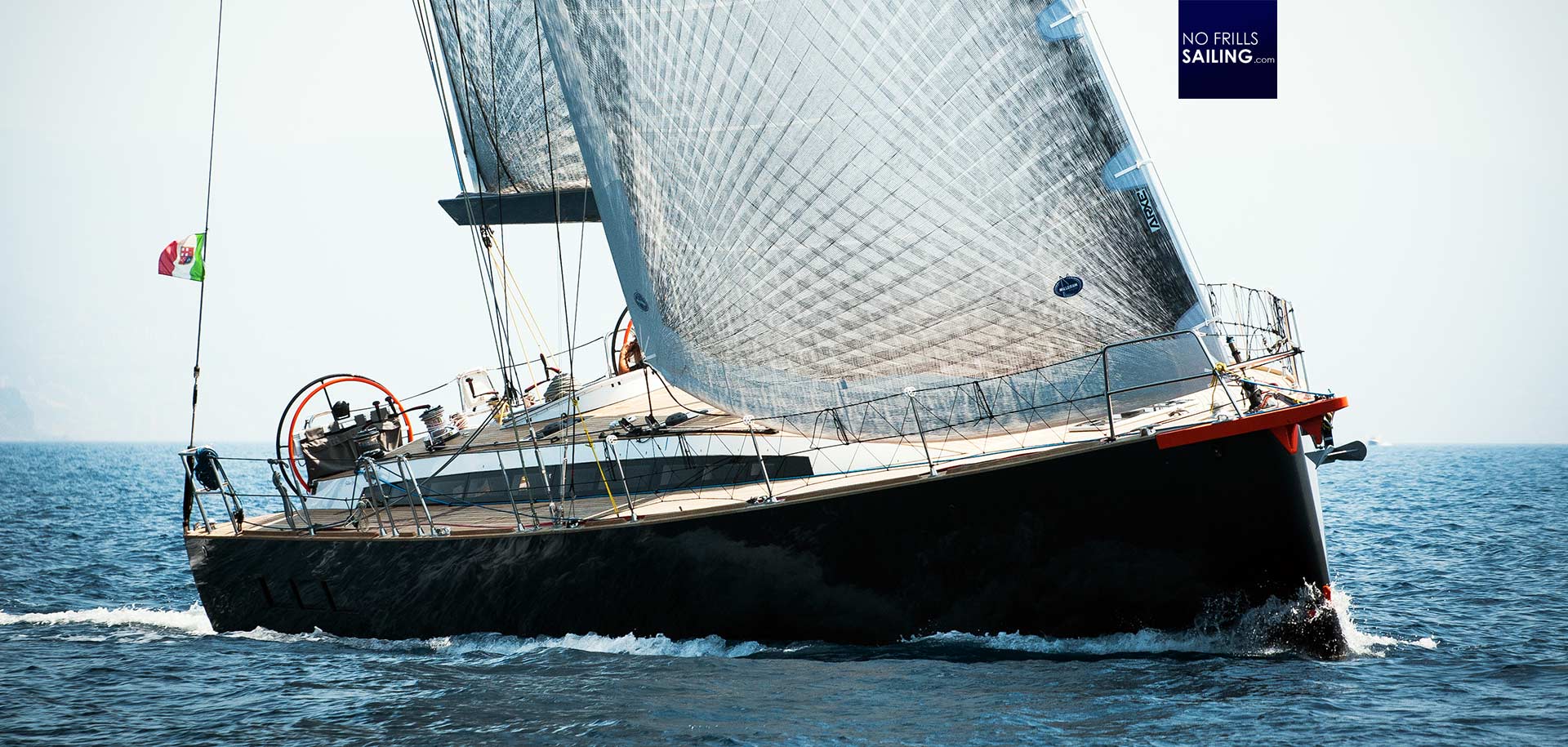With Italy being in complete shutdown and much of the boating industry in shock, these are difficult times for us all. In this I am thankful and happy having managed to find Alessandro Valenti, yacht designer and executive designer behind the fabulous Gulliver 57 sailing yacht, cooperative and willing to do an interview on the boat: I know that there may be much more urgent topics right now, anyway, a dictraction from the horrible scenes especially in Lombardy, birthplace of the Gulliver, is appreciated. Thank you Alessandro in advance. So, the Gulliver 57: A boat I was fascinated by from the first moment I saw her.

She is a big boat, some 19 metres in length over all, boasting 187 square metres sails area in the cruising version to up to 193 square metres upwind sails area in the racing variant with a 330 square metres Gennaker, this yacht is unique. Or not so unique: She reminded me of my all-time favourite boat concept, the Cigale by Alubat first conceived by Jean-Marie Finot in the late 90ies and re-designed by Marc Lombard in the early 2000s. But she is much more than an “Italian copy” and here is the story of how the Gulliver 57 came to life.
Meeting Alessando Valenti, executive designer behind Gulliver 57
NO FRILLS SAILING.com | Lars Reisberg: “Alessandro, thanks again for taking your time to talk to me. At first, please describe your professional background and your role in the Gulliver-project.”
Alessandro Valenti: “Well, that´s a short matter: I hold a degree in architecture and I am a Master of Yacht Design by Milan Polytechnic University. Since the year 2006 I am working actively in the nautical business and I spezialized in the design and construction of aluminium blue water sailing boats. My first real project was the Necton 45 which I worked on in close collaboration with Aldo Gatti: An explorer-type sailing yacht with a centerboard designed for navigation in artctic waters. I guess it was my overall experience in designing aluminium boats which predestined me for taking over the Gulliver-project in 2011, for which I was assigned executive designer and directing all works regarding customization management and construction supervision.”

NFS.com: “When and how did works on the Gulliver 57? Tell me about the connection to Marc Lombard and the Cigale-design.”
Alessandro Valenti: “Originally the Gulliver 57 had been designed by Marc Lombard for an owner who wanted a fast, safe, comfortable and elegant boat. It was around the year 2010 when no production model was out on the market meeting the needs of the client. As for the Cigale 16 which at that time had already been introduced by Alubat there was no lifting keel version available and the Cigale 18 didn’t exist yet. In short, it was the time before Cigale 18: So the French Alubat shipyard was unable to satisfy the client´s requests for modifications both on deck and in the interior layout and details. No, that was the hour of birth of the project: The owner, Carlo Gulotta, built a one off boat by Marc Lombard on his own specific needs.”

NFS.com: “That is very interesting. Why did Carlo chose the Cigale and no other boat as the blue-print?”
Alessando Valenti: “After the general design phase I was contacted by Mr Gullotta to organize the construction of the boat in Italy. Marc Lombard gave me an in-depth briefing. He by the way proved to be very willing to illustrate and share his ideas. We then began to work on further interior and deck customizations and produced all the cutting files and construction drawings of the boat.”

NFS.com: “What are the conceptual differences between a French-built Cigale and the Italia-made Gulliver? What is the idea behind the Gulliver yacht in general?”
Alessando Valenti: “The key difference is that our yard, Gulliver Sail, is very flexible in building the very boats. We are always remaining consistent with the initial project but in this the shipyard can adopt any modification both to the interior layout and to the deck according to the specific needs of the shipowners. In essence these are total custom yachts.”

NFS.com: “Talking details – in which respects is the Gulliver 57 different to the Cigale?”
Alessando Valenti: “The construction features of Gulliver yachts are based on a few clear concepts: Safety, lightness and finally of course comfort. When it comes to safety, I can state that the aluminum construction itself is a very robust construction due to the characteristics of the material itself. The Gulliver 57 is built as a completely closed, monolithic hull. This gives a high stiffness to the hull as a whole eliminating any junction problems between the hull and the deck. All high-load elements are structurally bonded with the internal structures of the hull. Thus avoiding a concentration of effort and discontinuity between structures. Of course, the boat is equipped with two fully watertight aluminum bulkheads plus a crash box at the extreme bow to protect against any high-speed impacts.”

Alessando Valenti: “Furthermore, the lifting keel is designed and made so that you can’t be disconnected and fall off even after a very violent hit. Also, the two rudder blades and bow thruster are located beyond watertight bulkheads. The safety of the boat is also achieved through the easy management of all facilities. The systems are well positioned so that they are easily accessible. All the boat’s panels are removable and there are three bilge which are independently from each other. Looking at the engine, it is positioned in the center of the dinette which is removable with with ease and made fully inspectable on the four sides and from above. Also, any point of the hull or deck can be reached from the inside without having to take away any furniture. All furnishings, in addition to being removable, are always equipped with openable funds. Finally, there are no entire rooms lowered into the hull without the deck but, given the closed-hull construction, all the furnishings pass through the companionway or the deckhouse side windows. This means that in case of need you can disassemble quickly and without doing damage.”

NFS.com: “You mentioned lightness of the built, which in case of an aluminium yacht this size must be superior to that of GRP-made yachts. Can you tell me more on this?”
Alessando Valenti: “Of course, lightness is one of the key features of Gulliver Sails. The aluminium structure is designed to achieve maximum stiffness with the minimum weight. That means that all frames are lightened and reinforcements are done in areas where needed and where the greatest stresses are supposed. All furnishings are made of lightened plywood sandwich, there are no needless panels or elements just for decorative effects. We restrained on adding real functional elements only.”
A real boat for real sailors
NFS.com: “Which brings us to the comfort. I´ve had the pleasure to visit the Gulliver 57 two times yet and I was absolutely blown away by the finishing quality, the richness in interior – but being “shiplike” and practical at the same time. No showing off …”
Alessando Valenti: “True. First of all, we chose all materials to be first choice and of best quality in the first place. They have been made and assembled by very experienced craftsmen in our yard. The ergonomics of the entire boat are designed to facilitate any operation or movement – even in high seas underway. There are numerous handrails, the large galley and charting area have their right-sized workspaces and supports. Of course, there aren´t any sharp edges in the whole boat. All the teak frames are handrails themselves so the chances of getting hurt or falling are minimized.”

Alessando Valenti: “The deck layout can be, depending on the version of the boat, based on the need for racing in regattas or doing a leisure, easy cruise. It is at the choice of the owner. Also rig and sail plan are designed according to the specific needs of the owner, of course always within the parameters of the boat.”
NFS.com: “Where are the boats built? Tell me more about the production and possible highlights of the Italian made Gulliver-sailing yacht.”
Alessando Valenti: “The boats are built in Milan with craftsmen from different areas of Lombardy and Italy. They were carefully chosen based on their specific skills and we found ourselves with a heterogeneous but well-matched working group. All united by the same passion for boating and well-done work.”

NFS.com: “How many Gulliver 57 boats have been build or delivered so far and what can you tell in general about the owners? Who is buying a Gulliver yacht and what is she used for in general?”
Alessando Valenti: “To date we have managed to have two boats built. The first was conceived for the classic offshore regattas in the Mediterranean. The yacht is owned by an experienced owner and his partner on a cruise and then handled by a team of close-knit sailors in the regattas. The second unit, however, responds to the needs of a large family with the desire to spend as much time as possible on the boat, also organizing work and study on board – it´s optimized for quick long haul cruising with ease.”
On the future of Gulliver Sails
NFS.com: “Are there any plans for changes on the current boat or plans to widen the Gulliver-range of boats to smaller or even bigger yachts of this kind?”
Alessando Valenti: “In fact the shipyard is collecting some requests for a smaller boat but I also had the request to develop an idea for a slightly larger one. Of course we have to check for feasibility and of course economic figures.”

NFS.com: “We are currently expecting a global crisis. Regarding COVID 19: What is your thought on the current situation and the impact of Corona/Covid-19 on the boating industry? How do you think will this crisis affect the industry, customers and the future?”
Alessando Valenti: “Yes, sadly. This is a totally unexpected crisis and it is frankly difficult to predict its effects. At this moment, in Italy, all companies in the sector are closed and probably not all of them will reopen at the end of the crisis. After this world crisis, the perception of the planet’s fragility and ours with it will be more vivid, I am sure. I hope that the need for responsible use of resources and respectful approach of man to nature will emerge reinforced. Sailing can be a means of this approach.”
Thank you, Alessandro very much. Be safe in these times and I hope we can meet again when this craze is over in summer. Forza!
Photo credits: Martina Orsini, Luca d’Ambrosio, Gulliver Sail and Valenti Yacht Design
You may also like to read:
Breaking the egg at the convenient end: Meet the fabulous Gulliver 57 sailing yacht
Marc Lombard and Christian Picard on the new Cigale 16
Aluminium magic: A Berckemeyer BM 49 in the making
